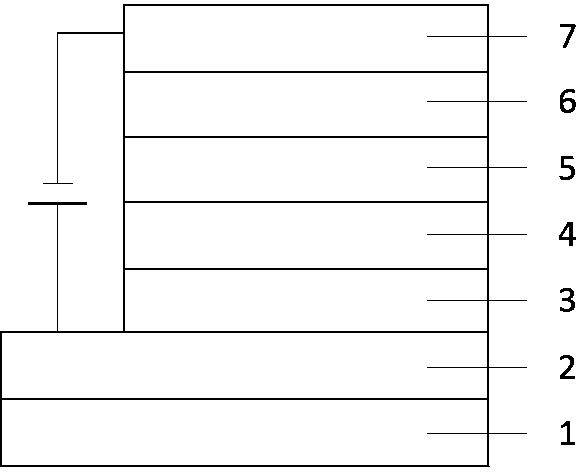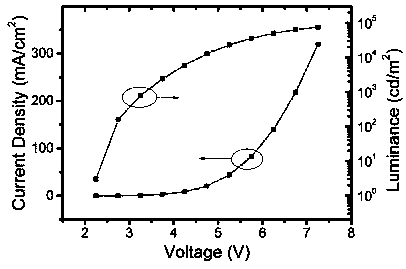Exciplex-based organic electroluminescent device and preparation method thereof
A technology of electroluminescent devices and exciplexes, which is applied in the direction of electric solid-state devices, semiconductor/solid-state device manufacturing, electrical components, etc., can solve the problem of increasing device operating voltage, unfavorable carrier injection, low carrier Mobility and other issues, to achieve the effect of reducing the operating voltage, reducing the concentration quenching effect, and improving the transmission capacity
- Summary
- Abstract
- Description
- Claims
- Application Information
AI Technical Summary
Problems solved by technology
Method used
Image
Examples
Embodiment 1
[0042] Such as figure 1 As shown, in the device structure, the anode layer 2 is ITO, the hole transport material 3 is TPAF, and the light-emitting layer 4 is TPAF:B3PYMPM:Ir(ppy) 2 acac(2.00:4.50:0.57), the electron transport layer 5 is B3PYMPM, the electron injection layer 6 is LiF, and the cathode layer 7 is Al. The entire device structure is described as:
[0043] Glass substrate / ITO(150nm) / TPAF(15nm) / TPAF:B3PYMPM:Ir(ppy) 2 The preparation method of acac(2.00:4.50:0.57, 30nm) / B3PYMPM(45nm) / LiF(0.8nm) / Al(80nm) is as follows:
[0044] ①Use detergent, ethanol solution and deionized water to ultrasonically clean the transparent conductive substrate ITO glass, and dry it with dry nitrogen after cleaning. Wherein the ITO film on the glass substrate is used as the anode layer of the device, the square resistance of the ITO film is 15Ω / sq, and the film thickness is 150nm.
[0045] ② Move the dried substrate into a UV-ozone treatment apparatus, and treat the ITO glass with UV-oz...
Embodiment 2
[0051] Such as figure 1 As shown, in the device structure, the anode layer 2 is ITO, the hole transport material 3 is TPAF, and the light-emitting layer 4 is TPAF:B3PYMPM:Ir(MDQ) 2 acac(2.00:4.50:0.13), the electron transport layer 5 is B3PYMPM, the electron injection layer 6 is LiF, and the cathode layer 7 is Al. The entire device structure is described as:
[0052] Glass substrate / ITO / TPAF(40nm) / TPAF:B3PYMPM:Ir(MDQ) 2 acac(2.00:4.50:0.13,30nm) / B3PYMPM(45nm) / LiF(0.8nm) / Al(80nm)
[0053] The fabrication process of the device is similar to that of Example 1.
[0054] from Figure 4 , Figure 5 And the test results can be seen in Table 1.
Embodiment 3
[0056] Such as figure 1 As shown, in the device structure, the anode layer 2 is ITO, the hole transport material 3 is TPAF, the light emitting layer 4 is TPAF:B3PYMPM:DCJTB (2.00:4.50:0.06), the electron transport layer 5 is B3PYMPM, and the electron injection layer 6 is LiF , the cathode layer 7 is Al. The entire device structure is described as:
[0057] Glass substrate / ITO / TPAF(40nm) / TPAF:B3PYMPM:DCJTB(2.00:4.50:0.06,30nm) / B3PYMPM(45nm) / LiF(0.8nm) / Al(80nm)
[0058] The fabrication process of the device is similar to that of Example 1.
[0059] from Image 6 , Figure 7 And the test results can be seen in Table 1.
[0060] Table 1: Test results of organic electroluminescent devices in Examples 1-3
[0061]
PUM
 Login to View More
Login to View More Abstract
Description
Claims
Application Information
 Login to View More
Login to View More - R&D
- Intellectual Property
- Life Sciences
- Materials
- Tech Scout
- Unparalleled Data Quality
- Higher Quality Content
- 60% Fewer Hallucinations
Browse by: Latest US Patents, China's latest patents, Technical Efficacy Thesaurus, Application Domain, Technology Topic, Popular Technical Reports.
© 2025 PatSnap. All rights reserved.Legal|Privacy policy|Modern Slavery Act Transparency Statement|Sitemap|About US| Contact US: help@patsnap.com



